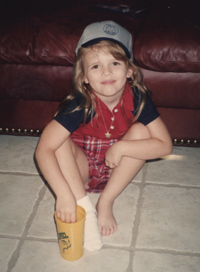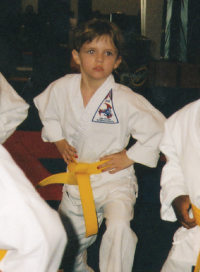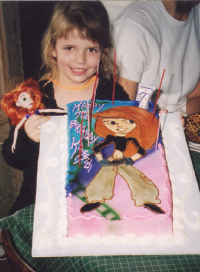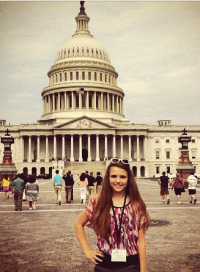Posted on Jul 31, 2017 in
COLLEGE DAZE

 Kassidi McKayla Kaminski is a sophomore studying Psychology in the Liberal Arts Honors Program at The University of Texas at Austin. After graduation she hopes to attend law school and is currently a member of Delta Gamma and a Young Life leader at Reagan High School.
Kassidi McKayla Kaminski is a sophomore studying Psychology in the Liberal Arts Honors Program at The University of Texas at Austin. After graduation she hopes to attend law school and is currently a member of Delta Gamma and a Young Life leader at Reagan High School.

A five-year-old Kassidi probably sorting the rocks she stole from Nana’s backyard.
By Kassidi McKayla Kaminski –
I do the same exact thing almost every day. As natural creatures of habit, we thrive on the consistency of routine and use it as a mechanism for self-preservation. When repetition is the backbone of life, how long is it until we are completely numb to it, simply existing instead of truly living?
I’ve found myself very dissatisfied lately. I constantly think about the averageness of my life and the mundanity of my daily routine. I have come to an existential crisis of sorts. On one hand, I rebuke myself for not fully enjoying the life I have or finding beauty in the ordinary. But on the other, I allow myself to give into the dissatisfaction and dream of the girl I would be if I wasn’t me. I’ve had dreams like these since I was a little. The girl I would be has looked different over the years, but I’m discovering today that parts of her have never changed.

My brief fling with karate,
a supplement to my spy aspirations.
When I was five, she looked like an archaeologist. She travelled the world in search of rare prehistoric fossils and ancient civilizations. Much like the Indiana Jones she saw in movies, she thwarted her enemies with her intelligence, bravery and sheer luck. Her passport was full of overlapping stamps of all the places she had been; she wasn’t tied down to any place in particular.
But I wasn’t an archaeologist; I was a seven-year-old child. So, I simply dug holes in my backyard and loaded the little pockets of my Old Navy shorts with rocks. The discovery was my high, the anticipation of things unseen and the pride I would win from uncovering them. I gasped with wonder whenever I found an animal bone or arrowhead (I still do). I kept a tub of them along with rocks, fossils and shells in my bathroom, the foundation for what I planned to be my first archaeological exhibit.
When I turned twelve, the archaeologist packed up her tools and left the door open for a girl with a business skirt, square-rimmed glasses, a leather briefcase, and a no-nonsense attitude.
She was a lawyer. And she was strong. Her intelligence morphed her words into invisible daggers, threatening to verbally destroy anyone who victimized her client. She defended the weak and sought justice for all.
This is the girl my parents always thought I would be due to my love for arguing and special interest in crime shows. I had a knack for solving the crime before the characters did and felt a righteous anger if justice wasn’t served. I practiced talking before a jury in front of my mirror, spouting phrases I had heard on television, such as “I object!” or “Ladies and gentlemen of the jury,” refining the skills any good lawyer would have.

Just a wannabe spy and her source of inspiration, Kim Possible.
And soon, just like the archaeologist, the lawyer bid farewell. But another girl didn’t come to replace her. I had reached a crossroads during my junior year of high school, a time where your teachers, parents, grandparents and mom’s Facebook friends all impart their opinions on where you should go to college and who you should be. Visions of doctors and lawyers and businesswomen and journalists flooded my vision in a never-ending revolving door. As a 17-year-old itching to escape the suburban private school life, I needed to visualize another, better version of myself in order to make my bubble seem bigger than it really was. I needed to answer the question for myself, like I had done with my imagination as an innocent child: who would I be if I wasn’t me?
Well, I’m now 20-years-old and still can’t settle on an answer to that question. I’m going to school for psychology, so it’s natural to think that the other me is flourishing in that field. Sometimes she’s a world-renowned psychiatrist, solving the mysteries of invisible illness and discovering life-changing treatment options in a research lab. But I ditched the pre-med track a long time ago, so the doctor doesn’t stay for very long.
Other days she’s a lawyer again, building new families through adoption, or even a spy, saving the world one stealthy mission at a time. Sometimes she’s a judge, or she’s drafting foster care policy reform as a senator in D.C. And the most impractical — yet dreamiest — other versions of myself are writing best-selling novels and musicals, in which she’s starring as the lead actress in eight Broadway shows a week. (This last one has taken residence in my brain recently; thanks a lot, Dear Evan Hansen.)

High school Kassidi left this trip convinced she would be Elle Woods 2.0.
It’s never wrong to dream. Every great thing that has happened in this world started from a dream. Dreams beget dreams. They reveal the most important parts of ourselves, the sparks of passion in our beings and the clues to our unique purposes in life. It’s unlikely that I’ll achieve a full cocktail blend of my dream-self: a lawyer who searches for ancient artifacts, stars in Broadway musicals, writes books and saves the world in her spare time.
But I’ve realized that parts of myself, the Kassidi I am right now, exist in all of these other me’s. I can take back the fragments and piece together my innate being. I am adventurous and curious like an archaeologist. I am a truth-seeker, a rule-changer and a problem-solver, just like a lawyer or a judge or a spy. I am just as empathetic as a psychologist and as creative as an actress.
I don’t know exactly what the best version of myself will look like. I’m sure some days I’ll still falter under the grip of dissatisfaction. But at least I don’t have to worry about becoming a writer. I’m doing that right now.


 <
<







 Kassidi McKayla Kaminski is a sophomore studying Psychology in the Liberal Arts Honors Program at The University of Texas at Austin. After graduation she hopes to attend law school and is currently a member of Delta Gamma and a Young Life leader at Reagan High School.
Kassidi McKayla Kaminski is a sophomore studying Psychology in the Liberal Arts Honors Program at The University of Texas at Austin. After graduation she hopes to attend law school and is currently a member of Delta Gamma and a Young Life leader at Reagan High School.


